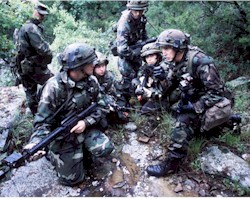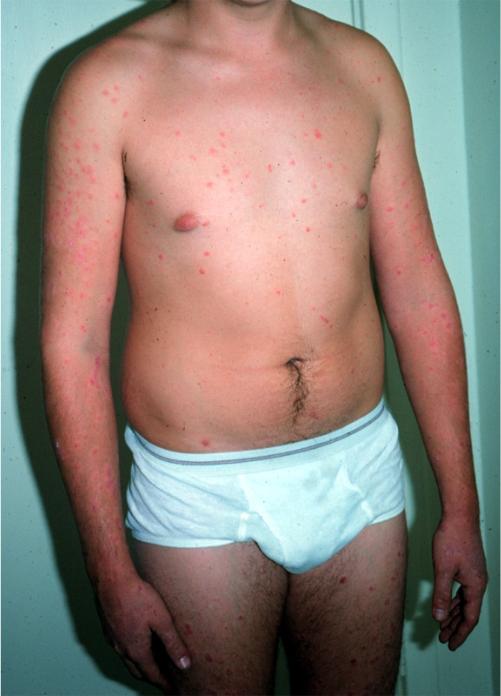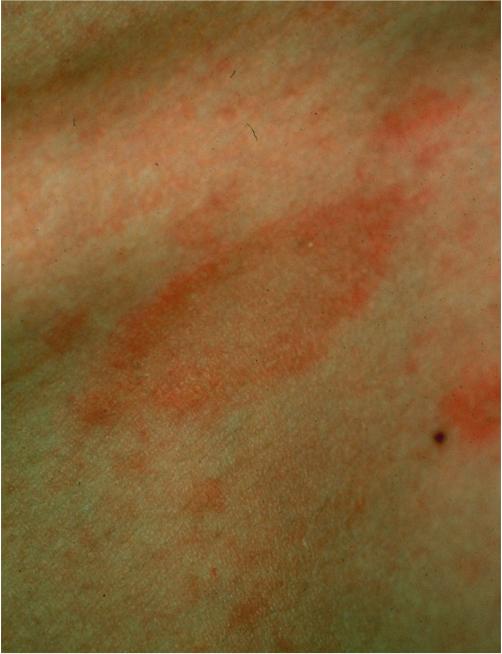Pityriasis Rosea
|
This benign but frequently annoying eruption is most commonly seen in the active duty age group. This condition is frequently in the primary care setting. A serologic test for syphilis or RPR (rapid plasma reagin) is absolutely mandatory to exclude the diagnosis of secondary syphilis. A truncal or proximal extremity slightly red, scaly 2-6 cm "herald patch" is not always seen or appreciated. The generalized eruption begins a few days to a couple of weeks later. Sometimes there is an antecedent history of a flu like illness. The individual lesions are 1-2 cm macules or patches, ovoid and have a peripheral "collarette" of scale. The "fir tree" pattern of distribution on the trunk is characteristic in fair skinned patients. In darker skin, the lesions may be more papular and concentrated on the skin of the infra axillary, upper medial thigh, and waistline. The presence of palm or sole lesions is quite unusual and should prompt the search for another diagnosis. The eruption usually lasts 6-8 weeks. Many cases are asymptomatic or produce little morbidity. Patients frequently require only reassurance. The majority of these patients can be returned to full duty. Some medications produce a pityriasis-like drug eruption. The most relevant drugs used by the active duty population are captopril, barbiturates, and metronidazole. Treatment with topical antipruritic
lotions, emollients, and conventional oral antihistamines should be
considered in pityriasis rosea patients with substantial pruritus. Written and revised by CAPT Dennis A. Vidmar, MC, USN, Department of Military and Emergency Medicine, and Department of Dermatology, Uniformed Services University of the Health Sciences, Bethesda, MD (1999). Additional images provided by CAPT Vidmar in June, 2000, subsequent to the initial publication of this manual. |
|
Preface · Administrative Section · Clinical Section
The
General Medical Officer Manual , NAVMEDPUB 5134, January 1, 2000
Bureau
of Medicine and Surgery, Department of the Navy, 2300 E Street NW, Washington, D.C.,
20372-5300
This web version of The General Medical Officer Manual, NAVMEDPUB 5134 is provided by The Brookside Associates Medical Education Division. It contains original contents from the official US Navy version, but has been reformatted for web access and includes advertising and links that were not present in the original version. This web version has not been approved by the Department of the Navy or the Department of Defense. The presence of any advertising on these pages does not constitute an endorsement of that product or service by either the Department of Defense or the Brookside Associates. The Brookside Associates is a private organization, not affiliated with the United States Department of Defense. All material in this version is unclassified. This formatting © 2006 Medical Education Division, Brookside Associates, Ltd. All rights reserved.
Home · Textbooks and Manuals · Videos · Lectures · Distance Learning · Training · Operational Safety · Search
|
|
|
This website is dedicated to the development and dissemination of medical information that may be useful to those who practice Operational Medicine. This website is privately-held and not connected to any governmental agency. The views expressed here are those of the authors, and unless otherwise noted, do not necessarily reflect the views of
the Brookside Associates, Ltd., any governmental or private organizations. All writings, discussions, and publications on this website are unclassified.
© 2006 Medical Education Division, Brookside Associates, Ltd. All rights reserved
Other Brookside Products


